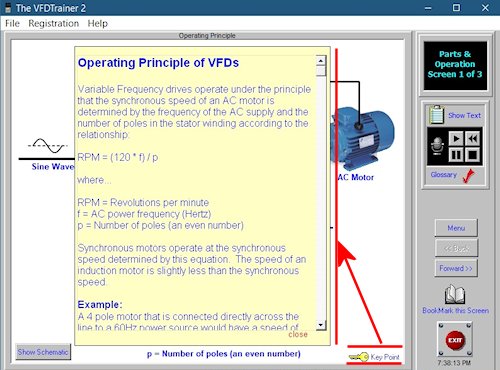Allen Bradley VFD Training: Sizing VFD for Motor: Key Points
- Home >
- articles >
- electrical >
- allen bradley vfd training

VFD drive working principles, sizing VFD for motor, and VFD Operating Temperatures.
Specifically, below are a few of the Key Points popups from the "Parts and Operation of a VFD" section of the VFD Training Certificate Course software.
VFD Drive Working Principles:
Variable Frequency drives operate under the principle that the synchronous speed of an AC motor is determined by the frequency of the AC supply and the number of poles in the stator winding according to the relationship:
RPM = (120 * f) / p
where...
RPM = Revolutions per minute
f = AC power frequency (Hertz)
p = Number of poles (an even number)
Synchronous motors operate at the synchronous speed determined by this equation. The speed of an induction motor is slightly less than the synchronous speed.
Example:
A 4 pole motor that is connected directly across the line to a 60Hz power source would have a speed of 1800 RPM.
(120) * 60) / 4 = 1800 RPM
If the motor is an induction motor, the operating speed would be approximately 1750 RPM. This is due to the 'slip' of the motor. Slip is generally 3% to 5% of the base speed.
If the same motor is connected to a VFD that provides power at 30Hz the synchronous speed would be 900 RPM.
(120 * 30) / 4 = 900 RPM
Sizing VFD for Motor:
How do you size a VFD drive for an application and feel confident it's going to work?
You must understand the requirements of the load. You should also understand the difference between horsepower and torque. Both torque and horsepower must be carefully examined.
Torque
Torque is an applied force that tends to produce rotation and is measured in lb-ft or lb-in. All loads have a torque requirement that must be met by the motor. The purpose of the motor is to develop enough torque to meet the requirements of the load.
The torque can be thought of as "OOUMPH". The motor must develop enough "OOUMPH" to get the load moving and keep it moving under all the conditions that may apply.
Horsepower
Horsepower (hp) is the time rate at which work is being done. One hp is the force required to lift 33,000 lbs. 1 ft in 1 min.
Some basic equations will help you understand the relationship between hp, torque, and speed.
hp = (Torque x Speed)/5250 (eq. 1)
Torque = (hp x 5250)/Speed (eq. 2)
For example, a 1-hp motor operating at 1800 rpm will develop 2.92 lb-ft of torque.
Know the load torque requirements
Every load has distinct torque requirements that vary with the load's operation; these torques must be supplied by the motor via the VFD. You should have a clear understanding of these torques.
Break-away torque
The torque required to start a load in motion (typically greater than the torque required to maintain motion).
Accelerating torque
The torque is required to bring the load to operating speed within a specified time.
Running torque
The torque is required to keep the load moving at all speeds.
Peak torque
Occasional peak torque is required by the load, such as a load being dropped on a conveyor.
Holding torque
The torque is required by the motor when operating as a brake, such as downhill loads and high inertia machines.
Practical VFD Sizing guidelines:
The following guidelines will help ensure a correct match of VFD and motor.
- Define the operating profile of the load to which the VFD is to be applied. Include any or all the "torques" discussed above. Using a recording true RMS ampmeter to record the motor's current draw under all operating conditions will help in doing this. Obtain the highest "peak" current readings under the worst conditions. Also, see if the motor has been working in an overloaded condition by checking the motor full-load amps (FLA). An overloaded motor operating at reduced speeds may not survive the increased temperatures because of the reduced cooling effects of the motor at these lower speeds.
- Determine why the load operation needs to be changed. Very often VFDs have been applied to applications where all that was required was a "soft start" reduced voltage controller. The need for the VFD should be based on the ability to change the load's speed as required. In those applications where only one speed change is required, a VFD may not be necessary or practical.
- Size the VFD to the motor based on the maximum current requirements under peak torque demands. Do not size the VFD based on horsepower ratings. Many applications have failed because of this. Remember, the maximum demands placed on the motor by the load must also be met by the VFD.
- Evaluate the possibility of required oversizing of the VFD. Be aware that motor performance (break-away torque, for example) is based upon the capability of the VFD used and the amount of current it can produce. Depending on the type of load and duty cycle expected, oversizing of the VFD may be required.
Key VFD specifications:
While there are many specifications associated with the variable frequency drive, the following are the most important.
Continuous run current rating
This is the maximum RMS current the VFD can safely handle under all operating conditions at a fixed ambient temperature (usually 40 [degrees] C). Motor ball load sine wave currents must be equal to or less than this rating.
Overload current rating
This is an inverse time/current rating that is the maximum current the VFD can produce for a given time frame. Typical ratings are 110% to 150% overcurrent for 1 min, depending on the manufacturer. Higher current ratings can be obtained by oversizing the VFD. This rating is very important when sizing the VFD for the currents needed by the motor for break-away torque.
Line voltage
As with any motor controller, an operating voltage must be specified. VFDs are designed to operate at some nominal voltage such as 240VAC or 480VAC, with an allowable voltage variation of plus or minus 10%. Most motor starters will operate beyond this 10% variation, but VFDs will not and will go into a protective trip. A recorded voltage reading of line power deviations is highly recommended for each application.
VFD Applications to watch out for
If you answer any of the following questions with YES, be extra careful in your VFD selection and setup parameters of the VFD.
Will the VFD drive operate more than one motor?
The total peak currents of all motor loads under the worst operating conditions must be calculated. The VFD must be sized based on this maximum current requirement. Additionally, individual motor protection must be provided here for each motor.
Will the load be spinning or coasting when the VFD drive is started?
This is very often the case with fan applications. When a VFD is first started, it begins to operate at a low frequency and voltage and gradually ramps up to a preset speed. If the load is already in motion, it will be out of sync with the VFD. The VFD will attempt to pull the motor down to the lower frequency, which may require high current levels, usually causing an overcurrent trip. Because of this, VFD manufacturers offer drives with an option for synchronization with a spinning load; this VFD ramps at a different frequency.
Will the power supply source be switched while the VFD drive is running?
This occurs in many buildings, such as hospitals, where loads are switched to standby generators in the event of a power outage. Some drives will ride through a brief power outage while others may not. If your application is of this type, it must be reviewed with the drive manufacturer for a final determination of drive capability.
Is the VFD motor load considered hard to start?
These are the motors that dim the lights in the building when you hit the start button. Remember, the VFD is limited in the amount of overcurrent it can produce for a given period of time. These applications may require oversizing of the VFD for higher current demands.
Are VFD motor starting or stopping times critical?
Some applications may require quick starting or emergency stopping of the load. In either case, high currents will be required of the drive. Again, oversizing of the VFD drive may be required.
Are external motor disconnects required between the motor and the VFD?
Service disconnects at motor loads are very often used for maintenance purposes. Normally, removing a load from a VFD while operating does not pose a problem for the VFD. On the other hand, introducing a load to a VFD by closing a motor disconnect while the VFD is operational can be fatal to the VFD. When a motor is started at full voltage, as would happen in this case, high currents are generated, usually about six times the full load amps of the motor current. The VFD would see these high currents as being well beyond its capabilities and would go into a protective trip or fail altogether. A simple solution for this condition is to interlock the VFD run permissive circuit with the service disconnects via an auxiliary contact at the service disconnect. When the disconnect is closed, a permissive run signal restarts the VFD at low voltage and frequency.
Are there power factor correction capacitors being switched or existing on the intended motor loads?
Switching of power factor capacitors usually generates power disturbances in the distribution system. Many VFDs can and will be affected by this. Isolation transformers or line reactors may be required for these applications. Power factor correction at VFD-powered motor loads is not necessary as the VFD itself does this by using DC internally and then inverting it into an AC output to the motor. All VFD manufacturers warn against installing capacitors at the VFD drive output.
VFD Drive Enclosure & Clearance Requirements:
Ambient VFD Operating Temperatures

To learn more, download the VFD Training Certificate Course software today. As you can see from the Key Points above, our courses take the practical real-world approach. Delivering information that took professionals years on the job to learn the hard way.
You may also be interested in our many unique electrical articles like "What do the letters FLA on a motor nameplate stand for?".

